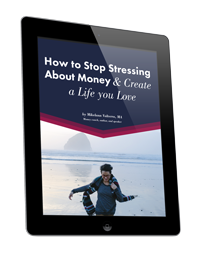In my last post, I talked about a gloriously boring savings concept called periodic savings. It was on how to handle all those stressful unexpected expenses and avoid credit card debt. Click here if you missed it.
Now I want to talk about your “freedom fund”. Some call this a “safety net”. Here is the traditional definition of a safety net that I bet you’ve heard somewhere: Ideally, you save up enough money to cover three months of your living expenses. That way, if something happens, such as unemployment, uncovered medical leave, or you want the freedom to wander the Himalayas for a few months, you can. Overwhelmed already? Keep reading!
It’s up to you if you want to call this a “safety net” or a “freedom fund”. Some money personalities respond more to “safety” and some personalities respond more to “freedom”. (And is it freedom from stress? Or enough safety to feel free?) What do you respond more to? Names are important. Name this savings in a way that speaks to you. In fact, this type of savings gets called all sorts of things–
• Prudent Reserve Savings
• Liquid cash Cushion
• Emergency Fund
• Freedom Fund
• Safety Net
• You can take this job and shove it Fund
They are all naming the same thing—this savings is simply a cushion against life’s larger curve balls—curves that take your income away for a while. And some curve balls are wonderful, and you want the freedom to reach out and catch them.
Perhaps you’re pregnant and want to take more time off, so your income will be zero for a while longer. Maybe someone invites you on a month long trip, and you can’t generate income while you’re gone. Perhaps you want to feel like you can leave your job and have time to job-hunt. Or you fear losing your job—your income– and you don’t want the stress of this weighing so heavily. (This fund also protects your investments, because it means you don’t have to drain your SEP or borrow against your 401k just because you don’t work for a while.)
It’s important to understand that your safety net/ freedom fund savings is NOT your periodic savings. It is money that you save up and only touch if you have an interruption in your income, whether for “good” or “bad” reasons. It is NOT money that is meant to be touched for car repair and other irregular expenses. That is the function of periodic savings.
Now, I realize this all sounds like a great idea, but I also know it can be overwhelming to imagine three months of income set aside. So a couple of points to help you–
• First of all, if you pull money from a safety net/ freedom fund, you are likely going to bring your spending down. (Translation- if you are living off your safety net/ freedom fund, you’re not doing a lot of shopping and eating out!) So this means that it’s okay to think about a “bare bones” month of expenses. What is the least you can get by on? Take that amount and multiply by three months as your goal.
• Also, don’t focus too much on three months. Set a goal to have one month’s rent in a dedicated savings account. This would feel great. Once you have one month’s rent in there, set a goal to get two weeks of income and then four weeks. Having a full month’s of expenses saved up feels fabulous. But start small.
• Set this account up as a separate savings account and simply save a set amount each month. So long as this is a separate account from your periodic savings account, then you shouldn’t need to touch it. It will just grow.
Imagine how it would feel to know that you could go for a while with no income. Would you feel more secure? Less stressed? More free? Would you feel like you could take advantage of a big opportunity that came your way, even if you didn’t work for a while? Even just setting up a Safety Net / Freedom fund, and transferring in $50 a month, feels great. Just get started.
You can do this. Because you deserve freedom AND security.
